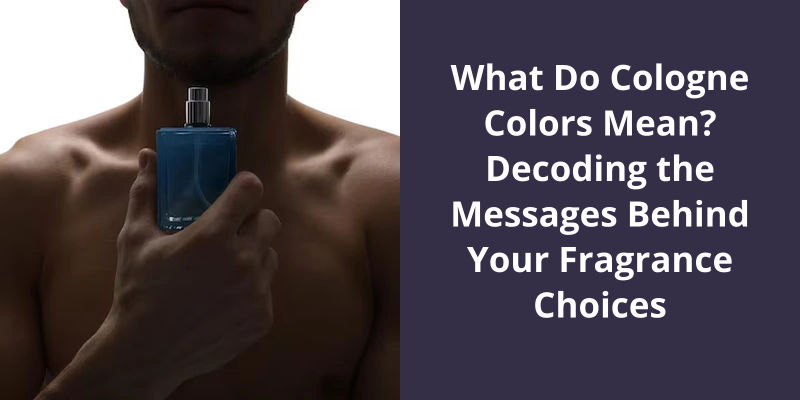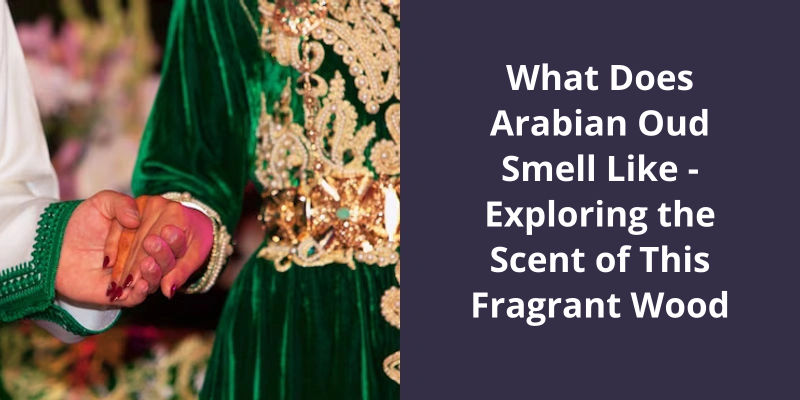Cologne colors represent various elements including ingredients, character, and strength. Dark-colored colognes like brown and amber usually indicate heavy scents with deep notes such as wood and spices, making them suitable for evening wear or colder seasons. On the other hand, light-colored colognes such as clear and pale yellow are often related to lighter, fresher scents with citrus or floral notes, making them a good choice for daytime use or warmer seasons. Lastly, colognes with a deep blue or green hue often signify sporty or marine fragrances. Nonetheless, it’s always important to try the cologne as packaging doesn’t always reflect the scent inside.

What Are the Main Types of Cologne?
Each type of cologne has a unique scent and level of concentration. Parfum is the most potent type of cologne with a concentration of 20-30%. This makes it the most expensive type of cologne, but also the longest-lasting. It’s ideal for special occasions and for those who want to make a bold statement. It still has a strong scent and is also long-lasting, but is slightly less expensive and more suitable for everyday wear.
Eau de Toilette is the most commonly used type of cologne. It’s a concentration of 5-15% and is lighter than the first two types of cologne. It’s less expensive and is perfect for those who want a fragrance that isn’t overpowering. Eau de Cologne is another popular type of cologne with a concentration of 2-4%. It’s even lighter than Eau de Toilette and is perfect for those who want a fresh and clean scent that isn’t too strong.
It’s a very light scent and is perfect for those who want a subtle fragrance that isn’t overpowering. It’s ideal for use during the summer months. Perfume Oil is the least concentrated type of cologne with a concentration of 1-2%.
Parfum is the most potent type of cologne and is perfect for special occasions, while Eau de Cologne and Eau Fraiche are ideal for everyday wear. Whether you prefer a strong or subtle scent, there’s a type of cologne for everyone.
Fragrance Families and Notes Commonly Found in Cologne (e.g. Fruity, Floral, Woody, Musky)
- Fruity
- Floral
- Woody
- Musky
The use of color in perfumery is a subtle yet effective way for manufacturers to communicate with their potential customers. While it may seem like a purely aesthetic decision, the color of a perfume can convey important hints about it’s scent profile and character. Understanding the meaning behind the color can help consumers make informed choices about which fragrances are right for them.
Why Are Some Perfumes Colored?
Perfumes are known to be a complex mixture of different aromatic compounds blended to create an appealing fragrance. However, not many people know that some perfumes are also colored for a specific reason. The color of a perfume not only makes it attractive but also denotes the nature of the scent. It suggests the personality type of the wearer and what kind of aura they want to carry.
For instance, scents that are light and refreshing such as citrus fruits are usually clear or pale yellow in color. These colors depict freshness, simplicity, and purity. On the other hand, fragrances that are rich and heavy like musk, amber, and patchouli are often darker in color. This shows the depth and complexity of the scent, suggesting it’s for someone with a strong personality.
The psychology of colors is used to create perfume colors that evoke a particular emotion in the mind of the wearer and those around them. For example, warm and sweet fragrances like vanilla and caramel are typically colored in shades of brown and gold, communicating a sense of comfort and stability. Likewise, floral and fruity fragrances are often colored in shades of pink and red, symbolizing femininity, romance, and passion.
The use of color in perfumery also creates an aesthetic value that appeals to consumers. When browsing perfume racks, color is one of the most prominent features that catches the eye. This helps in branding as color-coded bottles and packaging helps consumers to easily remember and associate a particular scent with the brand.
Depending on the color of the perfume, the wearer communicates their personality, mood, and lifestyle to the world. The color also plays a big role in catching the eye of potential buyers, making them more likely to purchase the product. So, the next time you choose a perfume, pay attention to the color, and discover what it says about you.
Source: In All the Colours of the Rainbow – Politech
Now that we know what a “blue” fragrance entails, let’s explore the different types of scents that fall under this category and what sets them apart from other marine fragrances.
What Does a Blue Cologne Mean?
The color blue has long been associated with the sea and sky due to it’s calming and serene qualities. When it comes to fragrances, a blue cologne is often used to evoke a feeling of freshness and freedom of the open sea. It’s a popular choice for those who want a scent that’s clean, airy, and distinctive. Many blue fragrances feature aquatic and mossy notes that bring to mind the salty ocean breeze and the crispness of the outdoors.
The popularity of blue colognes has grown enormously in recent years, and they’re now a staple of many mens fragrance collections. One of the reasons for their appeal is their versatility. Blue fragrances can be worn year-round and are suitable for both casual and formal occasions. They’re also popular with women, who enjoy the refreshing and invigorating scent.
One popular blue cologne that typifies the sea and sky scent is the legendary Aqua di Gio by Giorgio Armani. Released in 1996, it’s a classic summer scent that combines marine notes with citrus and a woody base. Another beloved blue cologne is Bleu de Chanel, which features a blend of citrus, spicy, and woody notes that creates an elegant and refined fragrance.
It’s a popular choice for both men and women and is a versatile fragrance suitable for all occasions.
When it comes to fragrances, there’s a world of options to choose from. Each scent carries it’s own unique personality and appeal to different kinds of individuals. However, dark colognes are in a league of their own with their characteristic heavy and rich aroma. The leather, wood, and smoke notes make them ideal for those who want to feel elegant and sophisticated. But what exactly do these dark fragrances say about the person wearing them? Let’s dive into the meaning behind a dark cologne.
What Does a Dark Cologne Mean?
A dark cologne isn’t only a fragrance, but an attitude. It represents the mysterious and sensual side of a man. It’s a scent that isn’t easily forgotten, leaving a lasting impression on those who come close to it. Dark fragrances speak volumes about a mans character and personality, making him stand out in a crowd.
Characteristics of Dark Cologne Scents
Dark cologne scents are bold, intense, and have a distinct richness that sets them apart. They usually feature deep, warm notes such as leather, tobacco, and musk. These fragrances are often described as mysterious, masculine, and sensual, with a certain air of sophistication. They’re designed for those who want to make a strong statement and leave a lasting impression. Overall, dark cologne scents have a unique character that captivates the senses and exudes confidence.
While the change in color may seem concerning, it’s actually a natural occurrence that happens to most perfumes. However, understanding the chemistry behind this alteration can give you a greater appreciation for the complexity of your favorite scent. So, why do perfumes change color? Let’s explore.
Why Did My Perfume Change Color?
As the acidity increases, the perfume starts to become darker in colour. Think of it as rust forming on metal over time, but in this case, it’s the perfume itself that’s reacting to the environment. This colour change is most visible in perfumes with lighter colours to begin with, such as clear or pale yellow.
The scent may still be perfectly fine, but it’s best to do a sniff test to confirm. In some cases, a perfume may have turned rancid due to the breakdown of oils or other ingredients. This can result in an unpleasant smell and a change in texture. If this is the case, it’s advisable to dispose of the perfume.
It’s also worth noting that not all perfumes will change colour over time. Some perfumes are specifically manufactured to avoid any reaction to light or air, and are packaged in such a way that prevents exposure to these elements. Additionally, perfumes with natural ingredients may change colour faster than those with synthetic ingredients. Natural ingredients are more prone to oxidation and other reactions than synthetic ones, which can result in a faster change in colour.
As with any product, perfume will eventually begin to break down and lose it’s effectiveness. It’s generally recommended to use perfume within 1-2 years of opening, depending on the make and storage conditions. After this time, the scent may still be usable, but it may have changed in quality or become weaker.
While this may be a cause of concern for some perfume lovers, it’s generally a natural and expected part of the fragrance lifecycle. With proper storage and usage, your favourite perfume can continue to delight your senses for years to come.
Now that we know how to properly store our favorite fragrances, let’s explore another question that often arises in the world of perfume: does the color of cologne really matter?
Does Cologne Color Matter?
However, color of the actual perfume itself may not necessarily indicate quality or longevity. Many perfumes, particularly those made from natural ingredients, will change color over time as they age and interact with the air and light. This can actually enhance their scent and depth.
Additionally, different perfumes may have different coloring due to the ingredients used in their formulation. For example, a perfume with floral notes may have a pale pink or yellowish tint, while a musk-based scent may appear darker or more amber in color. This color change is often intentional and part of the overall aesthetic and branding of the perfume.
Ultimately, the color of a perfume can be an interesting aspect to consider, but it shouldn’t be the sole factor in deciding whether or not to purchase or wear a particular scent. Other factors, such as scent notes, longevity, and personal preference, should be taken into account as well.
Counterfeit perfumes are often made to look as close as possible to the real thing, but may have differences in color or scent. To ensure that you’re purchasing an authentic perfume, it’s important to buy from a reputable seller and do your research on the brand and product.
Conclusion
Color interpretations aren’t only limited to those mentioned above but can differ from one person to another. Therefore, it’s essential to trust your nose and preference to select your perfect scent. In the end, the right color fragrance can enhance one's personality, boost confidence, and leave a lasting impression.





